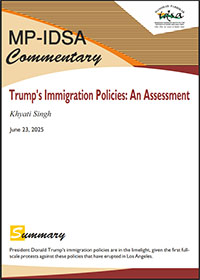Trump’s Immigration Policies: An Assessment
- June 23, 2025 |
- IDSA Comments
Executive Order 14163 ‘Realigning the US Refugee Admissions Program’ suspended US Refugee Admissions Program and cancelled all the decisions on refugee applications, thereby ending their resettlement process.[3] The rationale for this order was that the US has been ‘inundated with record levels of migration’, and allowing any further refugees would be determinantal to state’s interest.[4]
Although the order provides some respite on a case-by-case basis, but that would require the combined agreement of the Secretary of State and the Secretary of Homeland Security to admit that the admission of the refugee would not hamper US security, welfare, or national interest. The Executive Order has been criticised by organisations such as the International Refugee Assistance Project (IRAP), a non-profit with offices in the US, Germany, Jordan and Lebanon and has also generated several lawsuits.
Proclamation 10888 ‘Guaranteeing the States Protection Against Invasion’ was another order issued by Trump immediately after assuming office. It states that the ongoing influx of immigrants at the southern border is an ‘invasion’ and requires President’s constitutional authority to resolve the issue, and protect the state.[5] The proclamation suspended entry of any non-citizen engaged in this ‘invasion’, and barred them from seeking asylum or any other immigration benefits. Critics argue that the term ‘invasion’ is being used out of context, and misapplied. It could lead to the violation of rights of asylum seekers. The proclamation also empowers authorities to take ‘appropriate steps’ to expedite the removal of such invaders. This also enabled deportation of immigrants without complete court hearings.[6]
Executive Order 14165 ‘Securing Our Borders’ lays down a detailed strategy to enhance border security and address illegal immigration.[7] This order mandates physical measures to forestall the entry of immigrants including erecting a border wall along the southern border, to ensure ‘complete operational control’. It further emphasises the need for increased resources, both material and personnel to guard the walls, and ensure effective implementation of the orders.
It also annulled the ‘catch and release’ policy which allowed immigrants to roam freely till their proceeding was pending. It was replaced with detention to maximum extent authorised by law. The order reinstates the Migrant Protection Protocols (MPP), otherwise known as ‘Remain in Mexico’ policy that placed asylum seekers in Mexico till their claims are cleared in the US. The order also terminated the use of Customs and Border Protection (CBP) One application that facilitated asylum seekers to schedule inspections, and cancel pending appointments.
It suspended all the parole programmes that did not align with Trump’s policies, especially targeting programmes for Haitians, Venezuelans, Cubans and Nicaraguans.[8] In addition, the order empowers the agencies to pursue criminal charges against non-citizens violating immigration laws, and mandates the use of DNA testing to verify family relationships amongst the detained individuals. It also encourages the use of advanced technologies to track migrants and enhance border security.
Apart from these executive orders, another prominent legislative act was passed on 29 January 2025. The Laken Riley Act[9] enhances immigration enforcement as it mandates the detention of undocumented immigrants charged with specific crimes, especially the ones related to violence or theft. Moreover, the act rules out the possibility of bail. It affects people under programmes like Temporary Protected Status (TPS) or Deferred Action for Childhood Arrivals (DACA).[10] The most controversial aspect of the act is the power granted to states to sue the federal government over the decisions of immigration enforcement. As a result of this, detention rate of ICE facilities increased by 22 per cent within a month of passing of the act.[11]
While Trump is curbing immigrant entry to protect ‘American jobs’, on the other hand he has proposed a scheme to attract wealthy individuals. The Gold Card Residency Scheme is a proposal by Trump to attract wealthy foreign investors. It is intended to replace the current EB-5 immigrant investor visa. To get the gold card, an investment of US$ 50 million is required. This amount is intended to bring down national debt and stimulate economic growth through accelerated consumer spending and investment. As of now, the scheme is still in a nascent stage and the first cohort is expected to be admitted later in 2025.[12]
In addition to these initiatives, the administration also introduced major structural changes and enforcement operations to curb immigration. ICE initiated Operation Safeguard to detain and expel undocumented migrants, especially in urban areas. Historically, this operation was associated with the management of US–Mexico border, multi-phase enforcement strategies that include prevention and deterrence, targeted enforcement, coordination with local law enforcement, rapid detention and expulsion, public awareness campaigns and legal support.[13] Under this operation, nearly 23,000 arrests and 18,000 operations were made by March 2025.[14]
Following a memorandum issued by President Trump, the Guantanamo Migrant Operations Center (GMOC) has been expanded to accommodate approximately 30,000 migrants. Established in 1990s, it was aimed to house small number of migrants interdicted at sea. The memorandum directs Homeland Security and Department of Defense to set up additional space for “high-priority criminal aliens” present on the American soil.[15] The first flight that transferred migrants from US to Guantanamo took place in February, and makeshifts tents were set up to accommodate the large number of detainees. This expansion has harboured significant criticism, and has been labelled ‘cruel’, ‘immoral’, arguing that it peddles a narrative that demonises migrants and refugees.[16]
Furthermore, National Defence Areas (NDAs) have been established along the US–Mexico border to enhance military supervision in border security. National Security Presidential Memorandum (NSPM-4) formalised their creation.[17] This memorandum grants more freedom to the US military to install surveillance infrastructure and construct border barriers.
The administration claims that these actions have lowered the entry of illegal immigrants, and clears the way for ‘Make America Great Again’ initiatives by offering jobs to Americans. However, no effective evidence supporting these claims has been offered by the administration. Instead, the rigorous deportations and deterrent policies have curbed the labour pool of the country. The worst hit has been the technology sector which faces a talent bottleneck due to uncertainties regarding visas and work permits.[18] Moreover, there has been episodic incidents of migrants being treated like criminals, arrested, their visas being called off and subjected to humiliation. This has further discouraged skilled immigrants to apply for green cards, or jobs in America.
Reports note that industries like restaurant, hospitality, construction, and eldercare are suffering shortages of workers due to stricter checks and mass deportations.[19] The adverse effect of aggressive immigration policies would also be visible on the economy, with an expected US$ 30 to US$ 110 billion loss as a result of de-growth.[20] Despite facing backlash from within the country and outside, the administration has failed to accommodate the grievances of the immigrants. The US economy may, therefore, bear the negative effects of Trump’s immigration policies going forward, with shortage of labour and skilled workers.
Views expressed are of the author and do not necessarily reflect the views of the Manohar Parrikar IDSA or of the Government of India.
[1] “Los Angeles Protests: Anti-ICE Protests Spread Across US Cities”, Hindustan Times, 10 June 2025.
[2] “Executive Order 14160—Protecting the Meaning and Value of American Citizenship”, Administration of Donald J. Trump, govinfo.co, 20 January 2025.
[3] “Executive Order 14163-Realigning the US Refugee Admissions Program”, Administration of Donald J. Trump, govinfo.co, 20 January 2025.
[4] “Explaining Current U.S. Refugee Resettlement Policies”, International Refugee Assistance Project (IRAP), 7 June 2025.
[5] “Proclamation 10888 of January 20, 2025 Guaranteeing the States Protection Against Invasion”, Presidential Documents, Federal Register, govinfo.co, 29 January 2025.
[6] “Trump Continues Wave of Executive Orders and Actions on Second Full Day in Office”, CBS News, 22 January 2025.
[7] “Securing Our Borders”, The White House, 20 January 2025.
[8] “EO 14165: ‘Securing Our Borders’”, Immigration Policy Tracking Project, 20 January 2025.
[9] Laken Riley Act is named after a student named Laken Riley who was murdered by an undocumented immigrant.
[10] “What Does the Laken Riley Act Require?”, CLINIC, 21 February 2025.
[11] “ICE Detention Increases to Highest Levels Since 2019”, TRAC, 28 February 2025.
[12] “Trump’s US Gold Card Visa: What It Means for Wealthy Investors”, Forbes India, 17 March 2025.
[13] “Enforcement and Removal Operations”, US ICE, 28 April 2025.
[14] Albert Sun, “What the Data Shows About Trump’s Immigration Enforcement So Far”, The New York Times, 4 March 2025.
[15] Jnathan Hafetz and Rebecca Ingber, “What Just Happened: At Guantanamo’s Migrant Operation Center”, Just Security, 6 February 2025.
[16] “Beyond the Pale” – IRAP Denounces Trump Plan to Expand Detention of Migrants at Guantánamo Bay”, IRAP, 30 January 2025.
[17] “At Southern Border, Defense Secretary Visits Newly Created National Defense Area”, U.S. Department of Defence, 25 April 2025.
[18] Tomoko Ashizuka, “Trump Visa Scrutiny Expands Beyond Students to Tech and Business Staff”, Nikkei Asia, 3 June 2025.
[19] Megan Leonhardt, “Eldercare Employment is Under Stress. Immigration Curbs Are Why”, Barron’s, 6 June 2025.
[20] Wendy Edelberg, “Immigration and the Macroeconomy in the Second Trump Administration”, Brookings, 3 December 2024; “Mass Deportations Would Deliver a Catastrophic Blow to the U.S. Economy”, Joint Economic Committee, 11 December 2024.






